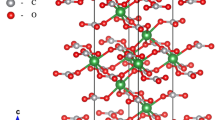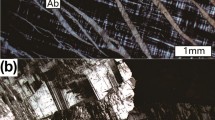Abstract
Pressure and temperature responses of natural phengite [K0.93Na0.03(Al1.46Mg0.45Fe0.09)(Si3.59Al0.39Ti0.02)O10(OH1.94F0.06)] in ultrahigh-pressure eclogite from the main hole of the China Continental Scientific Drilling Project (CCSD), the Dabie-Sulu orogenic belt have been studied using in-situ high-pressure mid-infrared and high-temperature Raman spectroscopic measurements up to ~ 20 GPa and 800 °C, respectively. Linear positive pressure dependences were observed for the infrared absorption bands associated with the aluminosilicate vibrations up to ~ 19 GPa, indicating the steady compression of the structure framework. The frequencies of the O–H stretching doublet bands, initially at 3601 and 3626 cm−1, displayed linear downshifts up to 16.6 GPa at − 2.02 and − 2.72 cm−1/GPa, respectively, implying high stability of the hydroxyl groups under compression. In the high-temperature Raman spectra, the bands initially centered at 265, 420, 703 cm−1, and the O–H stretching modes at 3620 cm−1 exhibited modest linear negative shifts with increasing temperature up to 800 °C. Comparisons between experimental results of the present study and those of the previous studies make it plausible that phengite with a higher Si content, i.e., a higher tetrahedral Si/Al ratio, would have higher stabilities under both high pressure and high temperature, and is likely to transport water to greater depths during subduction processes.










Similar content being viewed by others
References
Abbott RN Jr, Post JE, Burnham CW (1989) Treatment of hydroxyl in structure-energy calculations. Am Mineral 74:141–150
Amisano-Canesi A, Chiari G, Ferraris G, Ivaldi G, Soboleva SV (1994) Muscovite-3T and Phengite-3T: crystal-structure and conditions of formation. Eur J Miner 6(4):489–496
Bailey SW (1984) Crystal chemistry of the true micas. In: Bailey SW (ed) Micas, reviews in mineralogy. De Gruyter, pp 13–60
Celeste A, Borondics F, Capitani F (2019) Hydrostaticity of pressure-transmitting media for high pressure infrared spectroscopy. High Press Res 39(4):608–618
Chen S, Guo X, Yoshino T, Jin Z, Li P (2018) Dehydration of phengite inferred by electrical conductivity measurements: implication for the high conductivity anomalies relevant to the subduction zones. Geology 46(1):11–14
Domanik KJ, Holloway JR (1996) The stability and composition of phengitic muscovite and associated phases from 5.5 to 11 GPa: implications for deeply subducted sediments. Geochim Cosmochim Acta 60(21):4133–4150
Domanik KJ, Holloway JR (2000) Experimental synthesis and phase relations of phengitic muscovite from 6.5 to 11 GPa in a calcareous metapelite from the Dabie Mountains. China Lithos 52:51–77
Gatta GD, Rotiroti N, Pavese A, Paolo L, Curetti N (2009) Structural evolution of a 3T phengite mica up to 10 GPa: an in-situ single-crystal X-ray diffraction study. Z Kristallogr 224:302–310
Gatta GD, Rotiroti N, Lotti P, Pavese A, Curetti N (2010) Structural evolution of a 2M1 phengite mica up to 11 GPa: an in situ single-crystal X-ray diffraction study. Phys Chem Miner 37(8):581–591
Gemmi M, Merlini M, Pavese A, Curetti N (2008) Thermal expansion and dihydroxylation of phengite micas. Phys Chem Miner 35:367–379
Goryainov SV, Krylov AS, Polyansky OP, Vtyurin AN (2017) In-situ Raman study of phengite compressed in water medium under simultaneously high P–T parameters. J Raman Spectrosc 48(11):1431–1437
Guven N (1971) The crystal structures of 2M1 phengite and 2M1 muscovite. Z Kristallogr 134:196–212
Hermann J, Spandler C, Hack A, Korsakov AV (2006) Aqueous fluids and hydrous melts in high-pressure and ultra-high pressure rocks: implications for element transfer in subduction zones. Lithos 92(3–4):399–417
Huang WH, Yang Y, Qi ZM, Liu WD, Wang ZP, Liu Y, Xia QK (2021) Ammonium impacts on vibrations of hydroxyl and lattice of phengite at high temperature and high pressure. J Earth Sci. https://doi.org/10.1007/s12583-020-1113-4
Ivaldi G, Ferraris G, Curetti N, Compagnoni R (2001) Coexisting 3T and 2M1 polytypes of phengite from Cima Pal (Val Savenca, western Alps): chemical and polytypic zoning and structural characterization. Eur J Mineral 13:1025–1034
Kobziev VF, Zakirova RM, Kostenkov NV, Ktylov PN, Fedotova IV (2017) Effect of deposition temperature on the structure and optical properties of zinc-selenide films produced by radio-frequency magnetron sputtering. Semiconductors 51(6):817–822
Li H, Zhang L, Christy AG (2011) The correlation between Raman spectra and the mineral composition of muscovite and phengite. In: Dobrzhinetskaya L, Wali S, Faryad S, Wallis S, Cuthbert S (eds) 25 years after first discovery of coesite and diamond. Elsevier, London, pp 187–212
Libowitzky E (1999) Correlation of O–H stretching frequencies and O–H⋯O hydrogen bond lengths in minerals. Monatsh Chem 130:1047–1059
Liu FL, Xu ZQ, Xue HM, Meng FC (2005) Ultrahigh-pressure mineral inclusions preserved in zircons separated from eclogite and its country-rocks in the main drill hole of Chinese Continental Scientific Drilling Project (0–4500 m). Acta Petrol Sin 21(2):277–292 (in Chinese)
Liu L, Zhang JF, Green HW, Jin ZM, Bozhilov KN (2007) Evidence of former stishovite in metamorphosed sediments, implying subduction to > 350 km. Earth Planet Sci Lett 263(3–4):180–191
Liu L, Zhang JF, Cao YT, Green HW, Yang WQ, Xu HJ, Liao XY, Kang L (2018) Evidence of former stishovite in UHP eclogite from the South Altyn Tagh, western China. Earth Planet Sci Lett 484:353–362
Liu Q, Jin ZM, Zhang JF (2009) An experimental study of dehydration melting of phengite-bearing eclogite at 1.5–3.0 GPa. Chinese Sci Bull 54(12):2090–2100
Mao HK, Xu J, Bell PM (1986) Calibration of the ruby pressure gauge to 800-kbar under quasi-hydrostatic conditions. J Geophys Res 91(B5):4673–4676
Massonne HJ, Fockenberg T (2012) Melting of metasedimentary rocks at ultrahigh pressure-Insights from experiments and thermodynamic calculations. Lithosphere 4(4):269–285
Massonne H-J, Schreyer W (1987) Phengite geobarometry based on the limiting assemblage with K-feldspar, phlogopite, and quartz. Contrib Mineral Petr 96:212–224
McKeown DA, Bell MI, Etz ES (1999) Vibrational analysis of the dioctahedral mica: 2M1 muscovite. Am Mineral 84(7–8):1041–1048
Momma K, Izumi F (2011) VESTA 3 for three-dimensional visualization of crystal, volumetric and morphology data. J Appl Crystallogr 44:1272–1276
Mookherjee M, Redfern SAT (2002) A high-temperature Fourier transform infrared study of the interlayer and Si–O-stretching region in phengite-2M1. Clay Miner 37(2):323–336
Mookherjee M, Redfern SAT, Zhang M (2001) Thermal response of structure and hydroxyl ion of phengite-2M1: an in situ neutron diffraction and FTIR study. Eur J Mineral 13(3):545–555
Nakamura D (2003) Stability of phengite and biotite in eclogites and characteristics of biotite- or orthopyroxene-bearing eclogites. Contrib Mineral Petr 145:550–567
Ono S (1998) Stability limits of hydrous minerals in sediment and mid-ocean ridge basalt compositions: Implications for water transport in subduction zones. J Geophys Res 103(B8):18253–18267
Pavese A, Ferraris G, Prencipe M, Ibberson R (1997) Cation site ordering in phengite 3T from the Dora-Maira massif (western Alps): a variable-temperature neutron powder diffraction study. Eur J Miner 9(6):1183–1190
Pavese A, Ferraris G, Pischedda V, Ibberson R (1999) Tetrahedral order in phengite 2M1 upon heating, from powder neutron diffraction, and thermodynamic consequences. Eur J Miner 11(2):309–320
Pawley AR, Jones RL (2011) Hydroxyl stretching in phyllosilicates at high pressures and temperatures: an infrared spectroscopic study. Phys Chem Miner 38:753–765
Poli S, Schmidt MW (1997) The high-pressure stability of hydrous phases in orogenic belts: an experimental approach on eclogite-forming processes. Tectonophysics 273(1–2):169–184
Rieder M, Cavazzini G, D’Yakonov YS, Frank-Kamenetskii VA, Gottardi G, Guggenheim S, Koval PV, Muller G, Neiva AMR, Radoslovich EW, Robert JL, Sassi FP, Takeda H, Weiss Z, Wones DR (1999) Nomenclature of the micas. Mineral Mag 63(2):267–279
Ross M, Takeda H, Wones DR (1966) Mica polytypes: systematic description and identification. Science 151:191–193
Rouxhet PG (1970) Hydroxyl stretching bands in micas: a quantitative interpretation. Clay Miner 8:375–388
Sassi FP, Guidotti CV, Rieder M, Depieri R (1994) On the occurrence of metamorphic 2M1 phengites—some thoughts on polytypism and crystallization conditions of 3T phengites. Eur J Mineral 6(1):151–160
Schmidt MW (1996) Experimental constraints on recycling of potassium from subducted oceanic crust. Science 272(5270):1927–1930
Schmidt MW, Poli S (1998) Experimentally based water budgets for dehydrating slabs and consequences for arc magma generation. Earth Planet Sci Lett 163(1–4):361–379
Schomburg J, Zwahr H (1997) Thermal differential diagnosis of mica mineral group. J Thermal Anal 48:135–139
Smyth JR, Jacobsen SD, Swope RJ, Angel RJ, Arlt T, Domanik K, Holloway JR (2000) Crystal structures and compressibilities of synthetic 2M1 and 3T phengite micas. Eur J Miner 12(5):955–963
Swope RJ, Jacobsen SD, Smyth JR, Domanik KJ (1997) Polytype distribution in phengite synthesized at 11 GPa. Eos 78:314
Taylor W (1967) The Raman spectra of cubic zinc selenide and telluride. Phys Lett 24A(10):556–558
Tuladhar A, Chase ZA, Baer MD, Legg BA, Tao J, Zhang S, Winkelman AD, Wang Z, Mundy CJ, De Yoreo JJ, Wang HF (2019) Direct observation of the orientational anisotropy of buried hydroxyl groups inside muscovite mica. J Am Chem Soc 141:2135–2142
Williams Q, Knittle E, Scott HP, Liu ZX (2012) The high-pressure behavior of micas: vibrational spectra of muscovite, biotite, and phlogopite to 30 GPa. Am Mineral 97(1):241–252
Zhang ZM, Shen K, Sun WD, Liu YS, Liou JG, Shi C, Wang JL (2008) Fluids in deeply subducted continental crust: Petrology, mineral chemistry and fluid inclusion of UHP metamorphic veins from the Sulu orogen, eastern China. Geochim Cosmochim Acta 72(13):3200–3228
Zhang M, Redfern SAT, Salje EKH, Carpenter MA, Hayward CL (2010) Thermal behavior of vibrational phonons and hydroxyls of muscovite in dehydroxylation: In situ high-temperature infrared spectroscopic investigations. Am Mineral 95:1444–1457
Zhang ZM, Xiao YL, Hoefs J, Liou JG, Simon K (2006) Ultrahigh pressure metamorphic rocks from the Chinese Continental Scientific Drilling Project: I. Petrology and geochemistry of the main hole (0–2,050 m). Contrib Mineral Petr 152(4):421–441
Zheng Y-F, Zhao Z-F, Chen R-X (2019) Ultrahigh-pressure metamorphic rocks in the Dabie-Sulu orogenic belt: compositional inheritance and metamorphic modification. In: Zhang LF, Zhang Z, Schertl H-P, Wei C (eds) HP-UHP Metamorphism and Tectonic Evolution of Orogenic Belts. Geological Society, London, Special Publications, 474, pp 89–132
Acknowledgements
This study was supported by the National Natural Science Foundation of China (Nos. 42172044 and 41802035), the Fundamental Research Funds for the Central Universities, and the JSPS KAKENHI (No. JP18H05224). The authors thank K. Ichimura for technical assistance of electron microprobe analysis; Q. Tang and Y. Zhang for the help of Raman experiments; T. Yoshino for TG-DTA measurement; and Y. Wen for discussion and help in TG-DTA data analysis. X. He acknowledges the support of the IGPEES, WINGS Program, The University of Tokyo.
Funding
Funding was provided by National Natural Science Foundation of China (Grant Nos. 42172044, 41802035) and Japan Society for the Promotion of Science (Grant No. JP18H05224).
Author information
Authors and Affiliations
Corresponding author
Ethics declarations
Conflict of interest
The authors declare that they have no conflict of interest.
Additional information
Publisher's Note
Springer Nature remains neutral with regard to jurisdictional claims in published maps and institutional affiliations.
Supplementary Information
Below is the link to the electronic supplementary material.
Rights and permissions
About this article
Cite this article
He, X., Zhang, L., Kagi, H. et al. In-situ high-pressure and high-temperature spectroscopic studies of phengite in ultrahigh-pressure eclogite: implications for water transport during ultra-deep continental subduction. Phys Chem Minerals 49, 24 (2022). https://doi.org/10.1007/s00269-022-01196-4
Received:
Accepted:
Published:
DOI: https://doi.org/10.1007/s00269-022-01196-4




